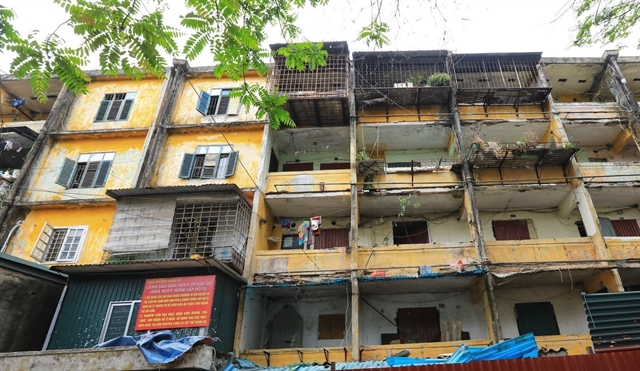 Society
Society

 |
| Households in the C8 Giảng Võ apartment building have been vacated. — VNA/VNS Photo |
HÀ NỘI — Renovation and reconstruction of old apartment buildings in Hà Nội have been slow to progress despite several solutions implemented over the last two years.
In order to make the city more beautiful and improve people’s living environment, the Hà Nội People's Committee two years ago approved a project of renovating and reconstructing old apartment buildings in the city.
Along with that, the Committee also issued six implementation plans to realise the project, including researching and detailed planning for renovating and rebuilding old apartment buildings for the years 2022-23 with four phases.
However, up to now, the plan has fallen into stagnation because no old apartment buildings have had their detailed plans approved.
According to representatives of the People's Committees of the districts, work has only been implemented at the stage of surveying, preparing and estimating budgets for approval.
Tạ Nam Chiến, chairman of the People’s Committee of Ba Đình District, said that the district, which has 217 old apartment buildings and five houses in dangerously degraded levels, had just completed surveying and preparing estimates to submit to the Department of Planning and Architecture for appraisal and then submit to the City People's Committee for approval for three big apartment building areas of Giảng Võ, Thành Công and Ngọc Khánh.
The next steps, such as organising bidding to select contractors and drawing up master and detailed projects, had not been carried out, said Chiến.
Recently, Trần Sỹ Thanh, the Hà Nội People’s Committee chairman and head of the steering committee for renovating and re-building old apartment areas in Hà Nội, admitted that the project's progress had not yet met the requirements of the schedule, especially the assessment of old apartment buildings and detailed planning.
According to the city Construction Department, the reason for the slow progress was due to problems regarding the legal basis for selecting consulting contractors.
In addition, some old apartment complexes have an area of about 20-30 hectares each and a large number of households (over 1,000) such as Giảng Võ, Ngọc Khánh, Thành Công, Trung Tự and Kim Liên.
Implementing the project will take a long time because it must be agreed upon by all the households.
Some apartment buildings which are not subject to demolition and reconstruction but are located in areas with dangerously degraded apartment buildings must be built synchronously but are lacking the consent of apartment owners.
In addition, under the Capital Construction General Planning and Urban Sub-division Planning, some existing apartment buildings do not conform to the planning, other buildings’ locations are planned to be green areas and parks, others are planned for one- to five-floor buildings or the existing population is higher than the planned population.
Due to being limited by the number of floors and population, it is difficult to ensure investment efficiency and attract investors to participate in renovating and reconstructing apartment buildings.
With a policy of not renovating each apartment building individually but rather carrying out a synchronous plan for renovation and new construction of the entire area, since 2016, the municipal government has assigned 19 investors to do research and create ideas for planning, renovating and rebuilding 30 old apartment buildings.
However, most investors that did research found that renovating and reconstruction were not feasible in terms of investment efficiency if the buildings’ height was limited as per the regulations on management of planning and architecture of high-rise buildings in the inner city area, said Nguyễn Bá Nguyên, deputy director of the Hà Nội Department of Planning and Architecture.
To solve obstacles to renovating and rebuilding old apartment complexes, the government issued a decree assigning provincial People’s committees to evaluate and approve detailed plans of the areas.
The committees are also responsible for approving plans of compensation, ground clearance and selection of investors.
According to the vice president of the Việt Nam Urban Planning and Development Association, Dr. Đào Ngọc Nghiêm, the decree helps remove obstacles for investors and managers.
The decree also regulates the population and number of floors for buildings in detail for specific areas.
The current problem is that localities need to speed up the organisation of bidding to select consultants for detailed plans for each old apartment building area. — VNS




